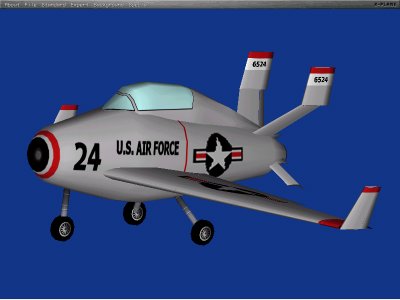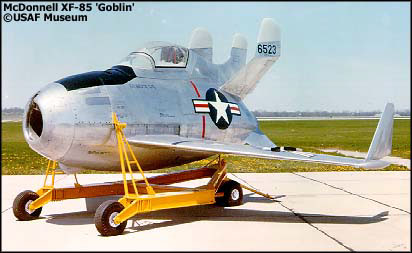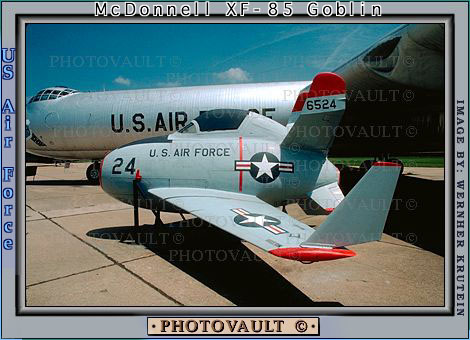 McDonnell XF-85 Goblin
McDonnell XF-85 Goblin McDonnell XF-85 Goblin
McDonnell XF-85 GoblinFrom the J Baugher McDonnell XF-85 Goblin page
On January 29, 1944, the Army Air Forces invited the industry to submit concept proposals for jet fighters capable of escorting its long-range heavy bombers. Since the first jet fighters were notorious fuel hogs, they promised to have insufficient range to escort the long-range B-35 and B-36 bombers then on the drawing boards. As one possible solution to this range problem, the USAAF revived the parasite fighter idea of the early 1930s, and proposed that one solution to the problem might be for the long-range bombers to carry their protective fighters right along with them.
The McDonnell Aircraft Corporation of St Louis was the only company to respond to the proposal. McDonnell proposed a small fighter aircraft to be carried partially inside a parent B-29, B-36, or B-35 heavy bomber. However, the AAF rejected this plan in January of 1945, concluding that the fighter would have to be carried ENTIRELY inside the B-35 or B-36.
On March 19, 1945, McDonnell submitted a revised proposal--a plan for a tiny aircraft with an egg-shaped fuselage, a triple vertical tail, a tailplane with pronounced anhedral, and vertically-folding swept-back wings. The engine was to be a 3000 lb.st. Westinghouse J34-WE-7 axial-flow turbojet with a nose intake and a straight-through exhaust. The aircraft was to be fitted with a pressurized cockpit and an ejector seat. Armament was to be four 0.50-cal machine guns in the forward fuselage sides.
The USAAF liked the McDonnell proposal, and on October 9, 1945 they ordered two prototypes (plus one static test article) under the designation XP-85. As a parallel development, the USAAF specified that the 24th and subsequent B-36s to be accepted by the service would be capable of carrying one P-85 in addition to the usual bomb load. It was even planned that some B-36s would be modified so that they could carry THREE fighters and no bomb load.
Conditional upon the results of flight trials with the XP-85, the AAF had intended to order an initial batch of 30 production examples, but before the completion of the first prototype this plan was shelved in favor of a more cautious approach in which only the two experimental aircraft would be acquired.
Since the XP-85 was to be launched and recovered from a retractable trapeze underneath its parent bomber, no conventional landing gear was fitted. A retractable hook was fitted to the fuselage in front of the cockpit. During recovery, the XP-85 would approach its parent bomber from underneath, and the hook would gently engage the trapeze. Once securely attached, the aircraft would be pulled up into the belly of the bomber. If an emergency landing were necessary, the aircraft was provided with a retractable steel skid underneath the fuselage, and the wingtips were protected by steel runners.
Since no B-36 could be spared as yet for the project, a Bell-Atlanta-built Boeing B-29B-65-BA (Ser No 44-84111) was specially modified for use as the mothership in the initial testing. Redesignated EB-29B, it was fitted with a special launch-and-recovery trapeze that would be used for the first test flights of the XP-85.
In June 1948, the XP-85 was redesignated XF-85 when the USAF replaced the prefix P for Pursuit by F for Fighter.
The first prototype XF-85 (46-523) was damaged at Moffett Field, California during wind tunnel testing, so it was the second aircraft (46-524) that was used for the initial flight trials. These began on August 23, 1948. Initially, the XF-85 made captive flights suspended beneath the EB-29B at 20,000 feet above Muroc Dry Lake (later Edwards AFB). The first free flight came on August 28. The test pilot detached his XF-85 from the EB-29B and flew free for 15 minutes while he evaluated the handling properties of the new fighter. However, when it came time to re-hook, he ran into trouble. The XF-85 was caught in violent air turbulence underneath the parent aircraft. After ten minutes of futile attempts to hook onto the trapeze, the XF-85 was slammed up against the trapeze and the canopy was shattered. Fortunately, the pilot was uninjured and he managed to make an emergency landing on the dry lake bed below.
Following repairs, 46-524 made three flights on October 14 and 15 of 1948. Three successful recoveries were made, although each one of them was a rather harrowing experience for all concerned. However, on the fifth flight, more trouble was encountered. The removal of the temporary fairing around the base of the hook resulted in severe turbulence and loss of directional stability, forcing the pilot to make another emergency landing. Vertical surfaces were added to the wingtips in an attempt to improve directional stability while flying in the turbulent air underneath the EB-29B. However, this did not help very much, and the sixth XF-85 flight ended in yet another emergency landing on the lakebed. The same fate awaited 46-523 on April 8, 1949, when it made its first and only flight.
In spite of the problems encountered with recovery, the XF-85 handled quite well in ordinary flight. Its test pilot commented favorably on the stability, control, and spin recovery characteristics. Estimated maximum speed was 648 mph at sea level and 581 mph at 35,000 feet. Initial climb was estimated to be 12,500 feet/min, and service ceiling was estimated at 48,000 feet.
However, the Air Force reluctantly concluded that since the recovery operation was so difficult a job for even experienced test pilots, it would probably be far beyond the capabilities of the average squadron pilot. In addition, it was projected that the performance of the XF-85 would likely be inferior to that of foreign interceptors that would soon enter service. Furthermore, a budget crunch in the autumn of 1949 led to a severe shortage of funds for developmental projects. Consequently, the Air Force terminated the XF-85 program on October 24, 1949.
Although the XF-85 Goblin was ultimately unsuccessful, it did provide some valuable data that was of use in the 1950s when the Republic RF-84F Thunderflash reconnaissance aircraft was adapted for launch and recovery beneath a B-36 bomber.
The original aircraft does not have flaps, but there is a fuselage mounted speedbrake shown in one photo I have in a book. It's rather odd looking, a perforated plate that is lowered down from the belly of the Goblin. The elevator surface is rather small, while the rudder area is conversely large, making for some challenging low speed handling. And of course I have include a retractable landing gear NOT found on the original!
The best way, however, to start your flight in the Goblin is from a B-52 drop. It has no bad tendencies and will zip right up to just under Mach 1 in a flash.
Landing the Goblin requires some planning and a BIG runway. The speedbrake is very effective but at low speed using the rudders will induce roll, so it's important to get lined up early. The landing gear is flimsy as well, so try to gently kiss the tires onto the runway, don't give it a big smack!
Download the McDonnell XF-85 Goblin version 1.0 (X-Plane version 5.62)



| Email James Z Temple | Return to Home Page |